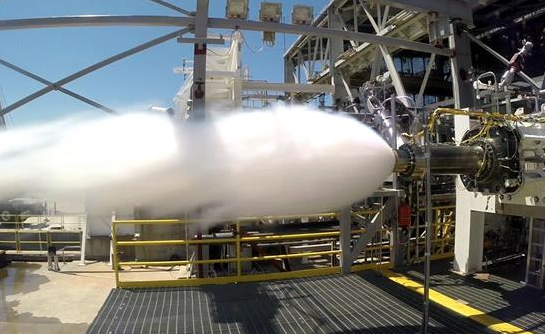
Another 'X' in the check box just moved the US one step closer to building and providing the US its own transport in space ... no more 'ride alongs' on Russian rockets and renting seats for US astronauts at exorbitant costs. Part of the testing process included the preburner, a critical component that drives the engine’s turbomachinery, was built using state-of-the-art techniques, including 3-D printing which features Aerojet Rocketdyne’s proprietary Mondaloy™ high-strength, burn resistant nickel-based super alloy.
Aerojet Rocketdyne, a subsidiary of Aerojet Rocketdyne Holdings, Inc. (NYSE:AJRD), recently conducted hot-fire tests to validate the design of the preburner for the AR1 rocket engine. This test and engine represent the nation’s lowest-risk, lowest-cost-to-the-taxpayer and fastest path to replacing the Russian-built RD-180 engine currently used to launch most US national security payloads into space.

Aerojet Rocketdyne tests its AR1 engine preburner, which was built using a proprietary alloy and 3-D printing technology, at NASA’s Stennis Space Center Aerojet Rocketdyne, Inc.
Aerojet Rocketdyne CEO and President Eileen Drake shared that this important milestone keeps AR1 squarely on track for flight readiness in 2019. Their proven design process and demonstrated manufacturing approaches are key contributors to Aerojet Rocketdyne’s unmatched record of mission success. When replacing the Russian-made engines on current launch vehicles, mission success has to be the country’s number one priority.
The preburner, a critical component that drives the engine’s turbomachinery, was built using state-of-the-art techniques, including 3-D printing which features Aerojet Rocketdyne’s proprietary Mondaloy™ high-strength, burn resistant nickel-based super alloy. With the design now confirmed, Aerojet Rocket has cleared one of the major technological hurdles to fulfill the congressional mandate to end US dependence on Russian engine technology for military launches.
Julie Van Kleeck, vice president of Advanced Space and Launch Programs and Strategy explained that due to the hot, oxygen-rich environment inside a staged combustion engine like the AR1, burn resistant materials are necessary to ensure safe operation of the engine under all conditions. Mondaloy 200™ alloy is the perfect material to use in the AR1, particularly when combined with 3-D printing, because it eliminates the need for exotic metal coatings currently used in the Russian-made RD-180 engine that the AR1 is designed to replace.
Testing is critical and repetitive. The AR1 engine development is using the same intense methods that the company has used for its previous successful engine development programs, such as the RS-68, J-2X, RL10, and RS-25. Prior to full engine testing, the company is assessing critical components and systems to validate the flight designs, ensuring that they are each strong prior to completing the flight engine design. Hundreds of component and subsystem tests along with manufacturing demonstrations have already occurred on the AR1 engine in advance of full engine testing. This approach minimizes changes once engine-level testing begins. The engine design team has now successfully completed a series of 22 component Critical Design Reviews leading up to an engine system Critical Design Review to support engine qualification and certification in 2019.

